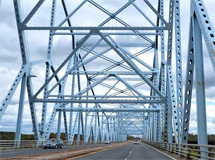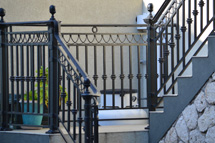Coatings
Thermal Spray Coatings
Thermal spray, or metallizing, was invented in 1910 by Max Ulrich Schoop. In the early years it was known as “schooping”. Soon thereafter the process was employed to spray zinc onto steel structures such as bridges, water storage tanks and barges. For 100 years metallizing has been used as a cost-effective, durable protective coating.
Metallizing with zinc or aluminum controls steel corrosion for the long-term. The value of metallizing is its long maintenance interval and as a result low life-cycle cost. It reduces the waste of resources and the cost to society caused by corrosion. Metallizing is the most effective coating for steel in harsh environments.
A metallized coating system is designed for a particular application and service environment. A metal coating of .006"-.008" will provide a very long service life in most environments. A metal coating of .010" of zinc may be specified for the inside of a potable water tank, while a coating of .015" of aluminum may be specified for certain high temperature applications, such as steam valves or compressor mufflers.
In the case of structural steel, a sprayed metal coating can provide a service life in excess of 20 years. The sprayed metal coating may be sealed and/or top coated with paint. This combined sprayed metal plus paint system is called a duplex coating.
“The total life of a duplex coating is typically 1½ to 2¼ times the sum of the lives of the metal coating and the paint or powder coating.”
ISO/TC 107/SC4 Guidance Document “Metal Coatings for the Protection of Iron and Steel in Structures”
Metallizing can be compared with hot dip galvanizing. These two metallic coatings are similar in some respects, but metallizing has some critical advantages. Pure aluminum and zinc-aluminum alloys may be sprayed. Aluminum and the zinc-aluminum alloy (85% zinc / 15% aluminum) are not usually available by hot dip galvanizing.
Metallizing is a "cold process" when compared with galvanizing. The steel surface remains cool with local temperature never exceeding 250-300° F. Welds are less likely to be damaged and steel is not likely to be distorted as can result when steel is immersed in the 800° F+ molten zinc in a galvanizing kettle.
Advantages
- The entire coating process, blast cleaning, metal spraying and sealing can be completed quickly.
- Ambient temperature does not limit metallizing as it does painting. Because metallizing can be done without the temperature limitations of painting, the “coating season" may be extended by several months. Critical bridges, water storage tanks and other structures may be coated during low demand periods; winter months.
- Structures of virtually any size or shape may be metallized in a shop or in the field.
When designing a metallized coating for your steel structure, many factors must be taken into account. Selecting an experienced thermal spray contractor is most important.
Aluminum Wire
Aluminum tends to passivate as aluminum oxide forms on the coating. Because the oxide is less reactive than the metal, it resists attack by corrosive agents such as sulfur dioxide in industrial atmospheres and chloride in marine environments.
- Aluminum pH range is 4 to 11.
- Aluminum is anodic to steel; so it protects steel galvanically.
- Aluminum may be used at elevated temperatures of up to about 1100° F (590° C). Sprayed aluminum has been used to coat the fire side of boiler tubes and large compressor mufflers.
- Additional applications include steel pilings above and below the mud and water lines, on steel in marine atmospheres, such as offshore oil platforms.
Zinc Wire
Zinc provides greater galvanic protection than aluminum. Its greater galvanic power protects damaged areas in the coating. Zinc dissipates over time, sacrificing in preference to the underlying steel.
- Zinc pH range is 6 to 12.
- Zinc’s service life is proportional to the weight of zinc coating.
- Zinc is easier to apply than aluminum. It is more forgiving than aluminum especially when applied in the field.
- Applications include steel bridges, the inside of potable water tanks, power transmission and communication towers and buried iron pipe.
- Thermal sprayed zinc is used for the cathodic protection of rebar set in concrete. There are two CP systems which use the sprayed zinc.
- Zinc should not be used in immersion service at temperatures above 140° F (60° C).
Zinc Aluminum Wire (85/15)
Sprayed 85/15 combines zinc with aluminum. Aluminum forms a tenacious oxide on its surface while zinc is more active and sacrificial.
- This alloy may be used for atmospheric corrosion control in industrial and marine environments. It has been used to coat navigation and irrigation dam gates and penstocks.
- The sprayed 85/15 coating may be used for salvage and repair of zinc aluminum parts. The alloy can be machine finished.



